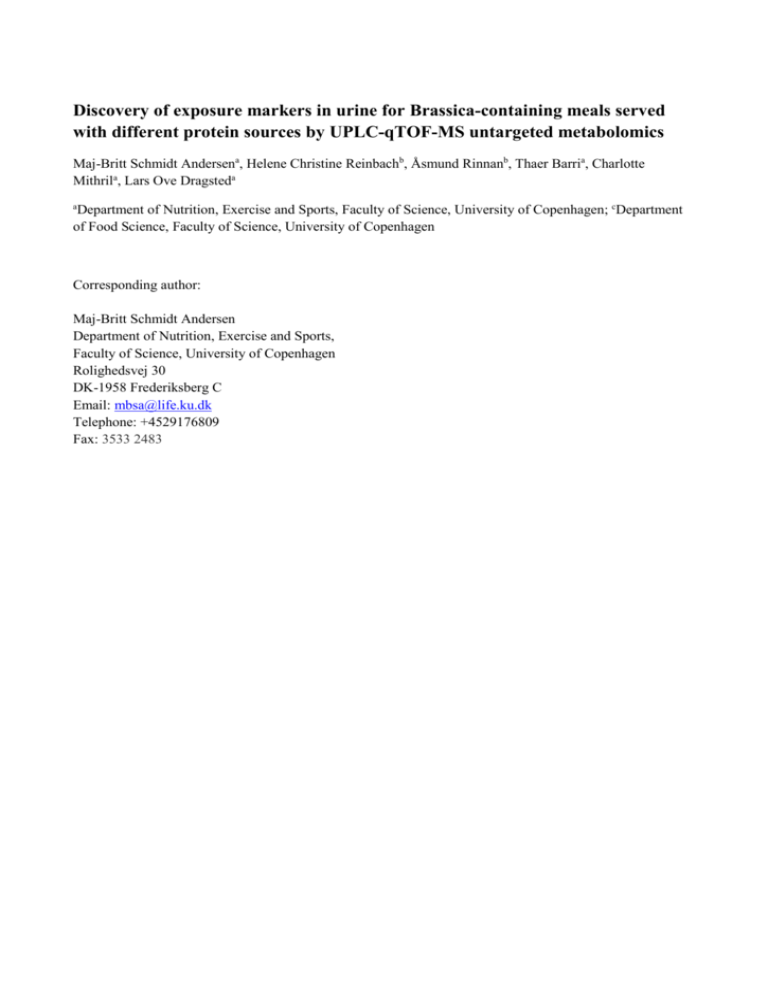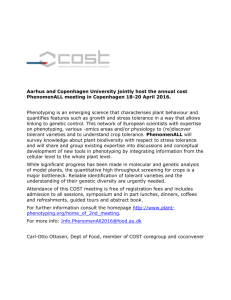Discovery of exposure markers in urine for Brassica
advertisement

Discovery of exposure markers in urine for Brassica-containing meals served with different protein sources by UPLC-qTOF-MS untargeted metabolomics Maj-Britt Schmidt Andersena, Helene Christine Reinbachb, Åsmund Rinnanb, Thaer Barria, Charlotte Mithrila, Lars Ove Dragsteda a Department of Nutrition, Exercise and Sports, Faculty of Science, University of Copenhagen; cDepartment of Food Science, Faculty of Science, University of Copenhagen Corresponding author: Maj-Britt Schmidt Andersen Department of Nutrition, Exercise and Sports, Faculty of Science, University of Copenhagen Rolighedsvej 30 DK-1958 Frederiksberg C Email: mbsa@life.ku.dk Telephone: +4529176809 Fax: 3533 2483 Supplemental material Table S1 Meal ingredients excluding protein sources Barleyotto 96.7 Soup 100.7 Pie 77.7 Rapeseed oil 5.8 2.5 8.8 Onion 15 15 15 Apple vinegar 2.5 2.5 2.5 Apple 40 40 - Apple juice 50 62.5 - White cabbage 25 25 - Brussels sprouts 20 20 - - 1.5 1 60 - - Cream cheese 12.5 - - Bouillon 150 - - Kale - 125 - Carrots - 62.5 - Parsley roots - 62.5 - Chicken stock - 125 - Wheat/rye/oat flour (2:1:1) Baking powder - - 50 - - 1 Yogurt naturel - - 25 Eggs - - 45 Skimmed milk - - 75 Broccoli - - 63 Pointed cabbage - - 38 Chicory salad - - 20 Wholemeal bread Garlic Pearl Barley Ingredients (in grams per single serving) used in the test meals excluding the protein sources. Foods highlighted in bold are food ingredients investigated in single food studies. Fish Table S2 Ingredients used as protein sources in the meals Monkfish cheeks Fillet of cod Barleyotto 25 - Soup 58 Pie - Smoked mackerel - - 26 25 - - - 54 - Vegetarian Meat Pig jaws Smoked saddle of pork Smoked haunch of venison 25 Fava beans 20 - - Brown beech mushroom 120 - - Poached egg - 75 - Split peas - 15 - Cottage cheese - - 40 Chanterelles - - 20 Ingredients (in grams per serving) used as protein sources for the meat, fish and vegetarian versions of the test meals. Foods highlighted in bold are food ingredients investigated in single food studies. Cooking methods for meals: Barleyotto The onion was chopped and sautéed in rapeseed oil before adding pearl barley which was left to sizzle for one minute. Then apple juice was added and one minute after also the bouillon. After simmering for 20 minutes, cream cheese was added. Vegetarian version: Fava beans were added to the pearl barley for the last 6-8 minutes of cooking. The brown beech mushrooms were fried for 2-3 minutes and mixed with the pearl barley before serving. Meat version: Pig jaws were fried in butter before adding apple juice and water. They were then left to simmer for 45 minutes and added to the pearl barley before serving. Fish version: Monkfish cheeks were fried in butter for 2 minutes and added to the pearl barley before serving. All Barleyotto meals were seasoned with salt and pepper and served with bread and a salad of Brussels sprouts, white cabbage and apple with a mixture of rapeseed oil, apple vinegar, salt and pepper as dressing. Pie Flour and baking powder were mixed into a dough with water and yogurt. The dough was rolled, put in a pan and baked for 15 minutes at 160°C. Onion and garlic were chopped and fried in rapeseed oil. Then, broccoli was cut and added to the pan with the onion. After beating eggs and milk, the mixture was poured over the vegetables and the pie was baked for 25 minutes at 150°C. Chicory salad was cut, mixed with the protein source and added on top of the pie before serving. Vegetable version: Cottage cheese was mixed with sliced chanterelles Meat version: Smoked haunch of venison (no preparation) Fish version: Smoked mackerel (no preparation) All Pie meals were served with bread and seasoned with salt and pepper. Soup Onion and garlic were chopped and sautéed in rapeseed oil before adding peeled and chopped carrots and parsley roots. Apple juice and chicken stock were added and the mixture was boiled until the vegetables were tender Vegetarian version: Split peas were boiled until tender. The egg was added to boiling water and poached for 5-8 minutes. Meat version: Smoked haunch of venison was served with chopped parsley. Fish version: Fillet of cod was baked in the oven with rapeseed oil. All Soup meals were seasoned with salt and pepper and served with bread and a salad of Brussels sprouts, white cabbage and apple with a mixture of rapeseed oil, apple vinegar, salt and pepper as dressing. Fig. S1 Outline of study design for Single-food studies (SFS). A schedule of meals and urine sampling for each study day is given on the timeline to the left. The right part of the figure shows the nine SFS meals. Table S3 Parameters and batch steps used for the processing of samples from the meal study and the single-food studies (SFS). Batch step Raw data import Chromatogram builder Negative mode Chromatogram deconvolution Isotopic pattern Join aligner Duplicate peak filter Peak finder Export to csv Raw data import Chromatogram builder Positive mode Chromatogram deconvolution Isotopic pattern Join aligner Duplicate peak filter Peak finder Parameters Noise level: 5.0E (15); Min time span: 0.01 (0.01); Min height: 5.0E1 (4.0E1); m/z tolerance: 0.06 (0.055 or 30 ppm) Chromatographic threshold: 98% (95%); Search minimum in RT range: 0:01 (0.01); Minimum relative height: 1% (10 %); Minimum absolute height: 5.0E1 (4.0E1); Min ratio of peak/top edge: 1.2 (1.3); (Peak duration range (min): 0.01-0.2) m/z tolerance: 0.06 (0.06 or 30 ppm); Retention time tolerance: 0:01 (0.01); Monotonic shape; maximum charge: 1 (1) m/z tolerance: 0.06 (0.06 or 30 ppm); Absolute retention time tolerance: 0:12 (0.15); Weight for both m/z tolerance and retention time tolerance: 10 (10) m/z tolerance: 0.06 (0.5 or 600 ppm); RT tolerance: 0:12 (0.15) Intensity tolerance: 20% (50%); m/z tolerance: 0.06 (0.06 or 30 ppm); Absolute retention time tolerance: 0:12 (0.15) Noise level: 4.0E1 (15); Min time span: 0.01 (0.01); Min height: 4.0E1 (4.0E1); m/z tolerance: 0.026 (0.055 mz or 30 ppm) Chromatographic threshold: 98% (97%); Search minimum in RT range: 0:01 (0.01); Minimum relative height: 1% (10%); Minimum absolute height: 4.0E1 (6.0E1); Min ratio of peak/top edge: 1.2 (1.5); (Peak duration range (min): 0.01-0.2) m/z tolerance: 0.026 (0.06 or 30 ppm); Retention time tolerance: 0:01 (0.01); Monotonic shape; maximum charge: 1 (1) m/z tolerance: 0.026 (0.06 or 30 ppm); Absolute retention time tolerance: 0:17 (0.15); Weight for both m/z tolerance and retention time tolerance: 10 (10) m/z tolerance: 0.026 (0.5 or 600 ppm); RT tolerance: 0:17 (0.15) Intensity tolerance: 50% (50%); m/z tolerance: 0.026 (0.06 or 30 ppm); Absolute retention time tolerance: 0:17 (0.17) Export to csv Samples from the meal study were processed in MZmine2.2 and samples from the single-food studies were processed in MZmine 2.7. The numbers used for SFS are given in brackets. Table S4 List of unknown PEMs found in the meal study Meal(s) m/z Barleyotto and Soup Pie Soup Barleyotto vegetarian meal Adduct/fragment/parent ion 261.093 RT (min) 2.01 205.096 255.048 403.229 345.188 191.143 325.167 301.157 287.150 311.153 297.136 306.103 158.088 179.011 1.94 0.93 4.05 3.83 3.58 4.14 4.20 4.09 4.00 3.97 2.64 0.77 0.49 [M+H]+ Pos mode [M+Na]+ [M+Na]+ Pos mode Pos mode Neg mode Neg mode Pos mode Pos mode Pos mode Pos mode Pos mode Pos mode Peak time 3 Present in other meals No 3 3 3 3 4 3 No No No No Yes No 3 3 3 3-4 3 3 No No Yes No Yes No Barleyotto fish meal The meals with highest levels of the feature are listed in the first column. Peak time is the urine sampling point, where the highest level of the feature was detected. None of the listed PEMs were confirmed in single food studies.







